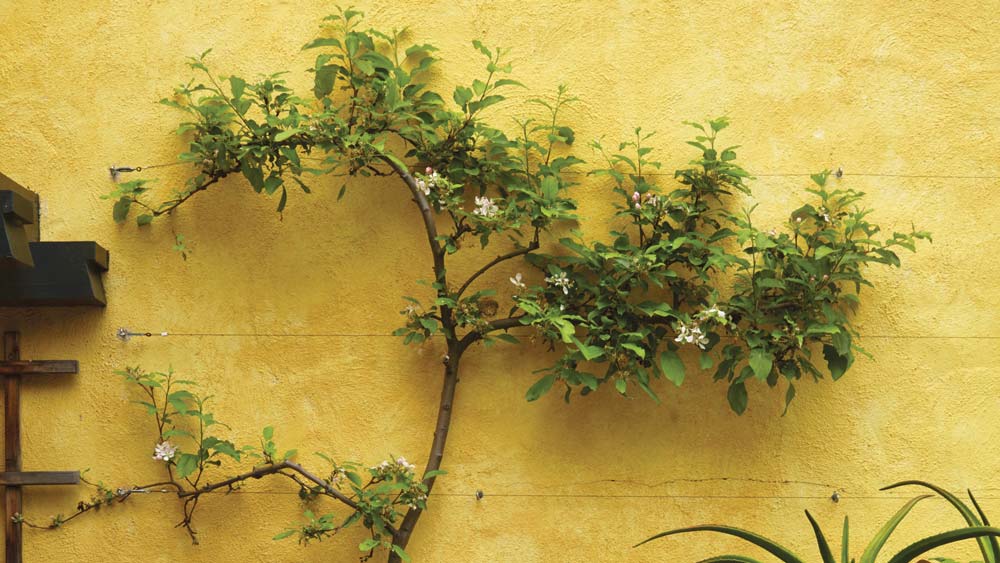
Photo: Jack Coyier; Design: Rebecca Sweet, Harmony in the Garden
If you think about a cabin garden that you’d want to spend hours enjoying, most likely it has several key features, including a variety of plant types, a harmonious balance of color and visually appealing elements that vary in height and width. These can often be achieved with tall shrubs or trellises, but another compelling choice is a fruit-bearing espalier.
espalier |es•pal•yay|
A French word derived from the Italian spalliera, or shoulder support.
Similar to pruning a bonsai so it retains a small, sculpted shape, an espalier involves training a young fruit tree into a flat, somewhat two-dimensional form that grows along a wall or trellis. Not only can this give your garden a distinctive look, particularly when the espalier is in the background, it also boasts a bonus: It’s easier to prune branches and harvest the fruit. Here’s how to start, train and maintain a fruit-bearing espalier.
Choose the right tree varieties and locations
Although you may be able to train a variety of fruit trees for your espalier, it’s helpful to pick ones that are already well-known for this type of effort. Apple and pear varieties are the most traditional species for espaliers and can live for decades while producing fruit. Depending on your geographic location, you may also train cherry, peach, plum, quince or fig trees.
It’s also important to plant the tree in the proper place, ideally a spot with full sun during the day and about 8 linear feet of space. Often the location is against a wall, but if you’re in a full-log home or have wood siding, find another area — perhaps against a brick or stucco wall, one clad with a cement-based siding material or a long, freestanding trellis — to plant your crops.
Plant and secure
Once you’ve identified the ideal location and have planted the tree, interweave some branches into the background support or secure them in some way, such as with small metal pegs or nails. You also can use twine or nursery tape, making sure to secure the branches while leaving the tips of each branch open for growth.
Train through pruning
After planting, prune the tree so it follows the supports of a trellis or wall. Regularly remove any weak shoots or suckers (the kind that grow between stronger branches) and prune throughout the growing season. To create additional tiers, prune the central stem in winter to stimulate side shoots that will become the horizontal arms of the next tier. In general, the initial training time is about two to three years as the tree becomes established, so this is when you’ll prune the most, but the process can be calming and even therapeutic.
Mulch, water and fertilize
Like any tree, a fruit-bearing espalier requires plenty of water as it matures. Young trees require a gallon of water every seven to 10 days at the start, but you may need more if the spot is particularly sunny or you live in a dry region. Adding mulch at the base of the tree can help with water and nutrient retention as well as weed suppression. Fertilize in early spring to kick off summer growth.
Much like any new gardening effort, start with a modest project to keep you inspired. That means rather than aiming for a sprawling stretch of wall, fence or trellis with several different varieties of trees, commit to training just one tree on a single, supportive trellis. As your fruit grows, so will your expertise, giving you the insight you need to keep adding to your fruit-bearing espalier collection.
3 Essential Steps to Shape 2D Trees
1. Let three new buds grow: two branches and a vertical leader.
Young trees grow faster in an upward direction, so train the side branches for a first season on bamboo sticks tied diagonally to the frame. In the fall, lower the sticks and branches to the first wire. Tie the branches to the wire and remove the sticks to use again.
Illustration: Tom Rosborough
Fruit-bearing Choices for Espalier
- Apple (Malus domestica): Tree; Honeycrisp and ‘Red Delicious’ are great spur-bearing varieties; full sun; cold zones 4 to 9
- Dwarf pear (Pyrus communis): Tree; ‘Bartlett’, ‘Kieffer’ and ‘Magness’ are good for espalier; full sun; cold zones 4 to 9
- Flowering crabapple (Malus hybrids): Tree; can be trained into complex espaliers; full sun or part shade; cold zones 3 to 9
- Flowering quince (Chaenomeles speciosa): Shrub; blooms on old growth; not all produce fruit; full sun or part shade; cold zones 4 to 8
Check out Garden Gate, our sister magazine, for even more helpful info. Subscribe at: gardengatemagazine.com/subscribe













